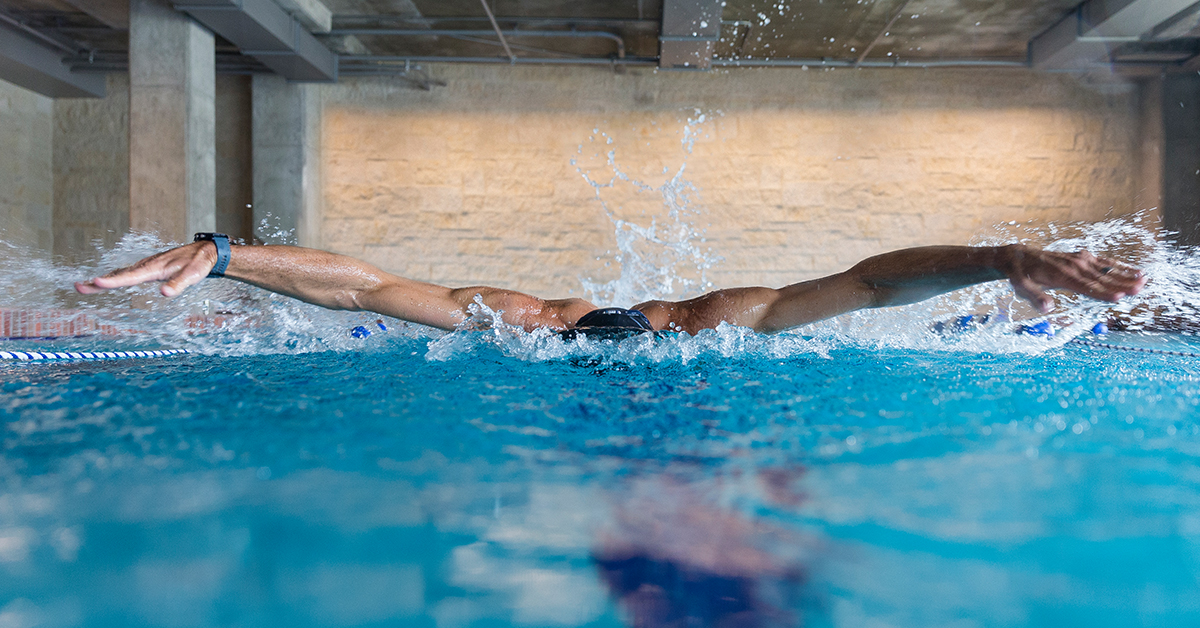
Swimming for Weight Loss
Swimming for healthy weight loss
Are you under the impression that certain kinds of swimming barely qualify as exercise, for example when silver-haired seniors glide up and down at a stately pace? If so, then you’re wrong! Swimming is a highly effective method of weight loss.
Gliding through the water with even strokes and a feeling of quasi-weightlessness — swimming often has something meditative about it. Surrounded by the blue tiles of the pool and the coolness of the water, you can let the daily stress wash away. But relaxation is not the only thing which pool-based workouts have to offer.
Swimming can also be used as a means of healthy weight loss. Unlike running, for example, swimming is gentle on the joints and ligaments. The buoyancy of the water provides a welcome break for joints which get enough wear and tear in everyday life. You only bear about 10% of your body weight when you are swimming.
The pool-based sport is also great for legs and can prevent varicose veins, spider veins, and swelling, since it takes the pressure off the veins. Swimming also strengthens your upper body, improves your fitness and conditions your cardiovascular system, cranks up your metabolism, and can help with neck or back problems because it relaxes your muscles and relieves tension.
Swimming for weight loss — why is it so effective?
Some people disparagingly refer to swimming as “counting tiles” because it is supposedly so monotonous and soporific. But nothing could be further from the truth! Working out in water trains many more muscles at the same time than most other sports, since it uses not only the leg and glute muscles, but also the arms, shoulders, chest, and back — the entire upper body, in other words. Swimming can even help you achieve the notoriously difficult goal of losing weight around the stomach. Water-based workouts are particularly good for your muscles because water provides 14 times the resistance of air.
What this means is that even an easy session in the pool can burn up to 500 calories per hour. And pool sessions where you really push yourself can torch as many as 700. These figures are based on breaststroke. Other strokes such as front crawl or butterfly may well achieve even higher calorie burns because they require more effort.
Blasting calories in the pool: form matters!
As we said, the maximum possible calorie burn in the pool depends on the individual stroke. But your form in the water naturally also plays a role. If you perform a stroke incorrectly, you’re more likely to pick up an injury than to lose weight. Your first step should therefore be to tune up your technique.
But which stroke sheds the most pounds? According to Elmar Trunz-Carlisi, sports scientist at the University for Prevention and Aftercare (IPN) in Cologne, crawl is the most effective stroke provided that the swimmer has practiced it to a level that he or she can go for long periods without a break and without gasping for breath. Crawl is also a particularly good choice for workouts which vary in tempo and intensity — an essential part of training for anyone who want to crank up the fat burn while they’re in the pool. It places a uniform load on the legs, lower body, and upper body, strengthening all your muscles at the same time.
But if you have yet to master the art of crawl, never fear — you can still lose weight with breaststroke. Many amateur swimmers prefer this stroke over all the others. And breaststroke is an equally good way to blitz your belly.
Swimming for weight loss — he who fails to plan, plans to fail!
Swimming is similar to land-based endurance sports in that weight loss is most easily achieved through interval training. Rather than ploughing up and down the lane at a comfortable speed, you should push yourself to swim faster and faster for short periods, followed by quick breaks. Drawing up a training plan every few weeks can help you stay on track.
A sample first week might look something like this. Three pool sessions per week:
- On the first day (Monday), warm up by swimming for 150 meters at a relaxed pace, then swim 10 x 100-meter intervals at a fast pace, with a 15-second break after each interval. Cool down by swimming for 150 meters at a slower pace.
- Take a day’s rest before the next training session.
- On Wednesday, repeat the 150-meter warm-up. This time complete 4 x 200-meter intervals at a fast pace with a 60-second break after each interval, followed by a 150-meter cool-down.
- On Friday, start with another 150-meter warm-up. Then complete a reverse ladder set by swimming intervals of 200/150/100/50 meters; repeat the entire set once. Take a 30-second break after each interval. Cool down by swimming for 150 meters.
Regular training increases the likelihood of success on the scales
How often should you visit the pool? As a general rule, you’re more likely to lose weight by swimming if you take the plunge three or four times each week, for 30 to 45 minutes at a time.
But all the training tips in the world won’t help you if you go too fast too soon and focus solely on torching as many calories as possible. This is bad news in terms of both endurance and technique. Instead, at least the first 100 meters of every training session should be a warm-up, and the last 100 or 200 meters should be a cool-down. During the main body of the workout, be sure to keep on varying your speed and the length of time for which you swim without a break.
Swimming for weight loss — tools of the trade
Are you turned off by the idea of simply powering up and down the pool? Are you looking for a bit more variety in your swimming life? There’s a range of different tools you can use to challenge yourself. Swim fins are a good example, and are suitable for beginners and experts alike. They make it possible to target your leg muscles and hone your lower body technique, and also to improve the flexibility of the ankle joints.
Paddles and pull buoys should only be used by swimmers with a bit more experience under their belt. Paddles can be described as flippers for the hands. They are used by swimmers to increase the size of their palms, which in turn increases water resistance. Making every stroke that much harder. Pull buoys are held between the upper thighs in order to give the hips more buoyancy. They increase the swimmer’s stability and improve his or her position in the water. This makes it easier to focus on the arms and ensure that they are performing the relevant movements with exactly the right technique.
The information provided through our blog or e-mails is not intended to be and is not a substitute for, professional medical advice, diagnosis or treatment that can be provided by your own health care professional. Garmin is not attempting to diagnose, treat or cure any physical ailment, or any mental or emotional issue, disease or condition. Our blogs are intended to help you reach your own health and wellness goals.




